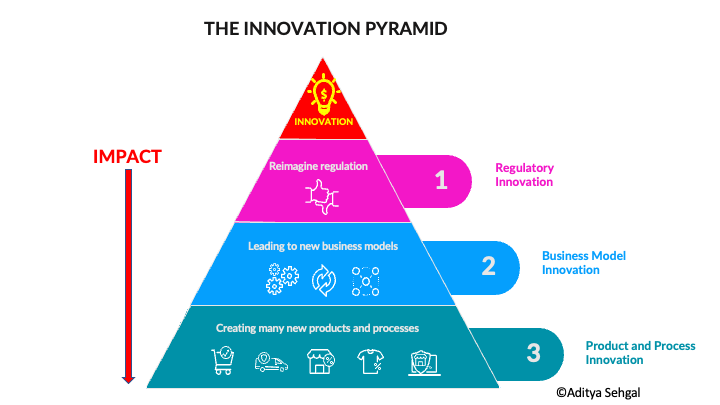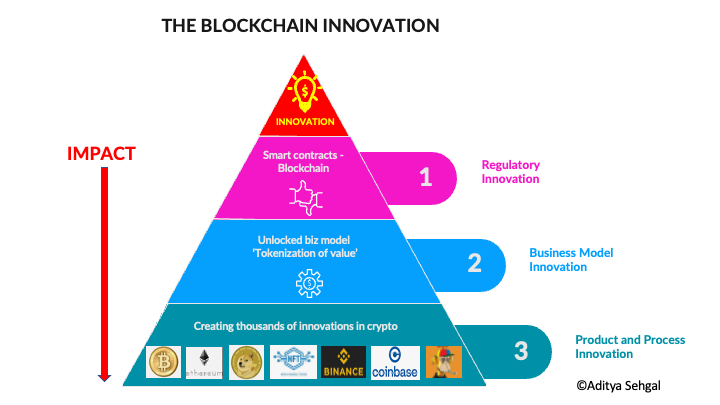The Framework:
The highest impact of innovation is at the top of the innovation pyramid.
One regulatory innovation creates multiple business model innovations. Each business model innovation unlocks multiples of product, brand and process innovations.
The higher up the pyramid, the higher the combined multiplier effect of the business model and then product innovation.
Innovating higher allows you to lock in the value, IP and network effects of the inevitable downstream innovation that follows, capturing a disproportionate share of the eventual profit pool.
Unfortunately, organisations believe that the business model is defined only by top management. We teach people that examining the regulatory framework is heresy. Top management focuses on micromanaging product innovation, and no one works on testing regulatory frameworks or inventing new business models.
The team only works on incremental product innovation, missing tremendous innovation opportunities. We flood the innovation funnel with activity, which has little impact.
New, nimble competitors disrupt regulatory boundaries and business models. They create innovation that reframes the industry and destroys slow incumbents.
By leveraging this framework and elevating your focus, you can unlock massive value for the organisation and yourself.
If you feel you are not allowed to question regulatory boundaries or the business model in your organisation, then first apply this pyramid to your mindset.
Disrupt the organisational ‘regulatory’ framework, which disempowers you from creating regulatory innovation and business model innovation.
Applications:
The gig economy business model:
There is a regulatory innovation behind the gig economy. Using private assets and enterprises to provide public services was not regulated (because regulators had never thought about this possibility).
Leveraging this ‘grey area’ in regulation, Airbnb created the ‘gig economy’ in Aug 2008 via a marketplace that allowed private citizens to participate in the hotel industry as providers. Uber allowed private citizens to participate in a transport marketplace as providers when they launched in 2009.
Multiple ‘product and brand’ innovations then leveraged the same ‘Gig economy’ business model with services like Meituan-Dianping. Deliveroo, Grab, Go-Jek, Rappi, Doordash, JustEat, Swiggy, Glovo and countless others.
The Blockchain and crypto innovations:
The regulatory innovation behind the crypto economy is using blockchain technology to create ‘smart contracts’ autonomously. The blockchain enables data to be published widely so it cant be overwritten. Blockchain disrupted the previous ‘regulatory system’ of recording contracts through legal contracting and notarisation.
Creating smart contracts at scale enabled business models around the tokenisation of value. Bitcoin was the first application - the tokenisation of money. Other business models coming out of the blockchain innovation include
DeFi (Decentralised finance): DeFi will disrupt banking. We will not need a bank as we know it today to prove ownership or record balances and transactions. Blockchains and smart contracts will replace legacy banks. Product innovations for DeFi will include distributed, autonomous ‘banks’ that have almost no employees and meagre costs, with high efficiency and security.
Web 3.0: Blockchain-powered links will replace the HTML links that power today’s internet. These are more secure - improving speed, reliability, privacy and safety. Product innovations will include new browsers, new ways to pay and new devices.
The tokenisation of everything: We will convert every physical or virtual asset (shares, property, possessions) into tradeable tokens (Non-fungible tokens or NFTs), which we can exchange for other tokens (in a barter economy) or money. Tokens can then be combined into derivatives and traded on exchanges.
New exchanges like Coinbase and Binance will rise to invent new sources of value while trading tokens.
And many thousands of business models + millions of product innovations.
Using the framework:
Start your innovation process by critically examining:
The purpose of your organisation
Your regulatory boundaries (what are you allowed/not allowed to do)
Your business model (how your business creates value and how you make money)
Set yourself a target to find at least one regulatory innovation. Look for boundaries in regulations and ask yourself what-if questions. Look for areas that are not regulated because no one has ever dreamt of the possibilities yet.
Of course, where regulations are clear and black and white, you must fully follow them in letter and spirit.
Liberate your team’s imagination to create new business models within both current and new regulatory boundaries. Target at least 3 new business models to play with.
Push the ability to create new business models down to lower levels in your organisation if you want a team that makes serial innovations that shake your industry.
Spend top management time on challenging and unlocking the barriers to regulatory and business model innovations. Manage product innovations by innovation pipeline metrics. Don’t let senior managers waste everyone’s time by micromanaging the tiny product innovations that don’t make a material difference.







Aditya, this is a fantastic framework. It triggers so many thoughts. Allow me to post a couple here and seek your opinion.
One question is around nomenclature. It seems that you use 'regulatory' as synonymous with technological, not legislation. My reference point for regulatory is Mike Maples backcasting model: https://medium.com/@m2jr/how-to-build-a-breakthrough-3071b6415b06
Second question is related to the first. How do you account for the role of mass belief changes that help with adoption at scale? For example, technology was good enough to allow remote work, but few businesses did that pre-COVID. That changed with the pandemic.
Love this framework !!! At the heart of it is to reimagine the way business operates and so to speak thinking out of the box . I think the challenge really is this ..most legacy organization are least likely to go down this path of rethinking regulations sheerly out of inertia and lack of risk appetite ( even now they are happy buying startups that setting up themselves :)) .Maybe thats why it took 3 young blokes to think of the Airbnb and not Marriott. And this is maybe the reason why the startup industry is thriving picking existing problems to solve ex. UC picking up cleaning services as a offering which RB could have done as well